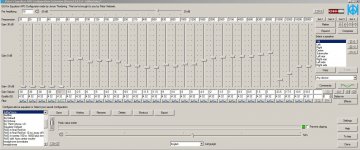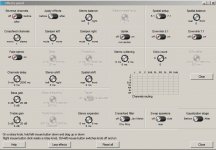Well, I guess I’m a little scared of the “math” part of MLTL design. Sealed seems a lot less picky, physics-wise. But maybe with help and some study time I can manage it!
If the footprint I have to work with is basically 5” w x 48” h x 24” d could I accommodate some kind of special MLTL to wring the most from a double tc9fd complement? Perhaps my starting point should be the existing on-wall MLTL design parameters?
I admit, I’m awfully enamored of spirals. Is it feasible to locate a port on the side of a speaker rather than front or back? A spiral terminates in the middle of a box, naturally, so it would be convenient to install a port through the sidewall into the inner terminating chamber of a spiral TL.
If the footprint I have to work with is basically 5” w x 48” h x 24” d could I accommodate some kind of special MLTL to wring the most from a double tc9fd complement? Perhaps my starting point should be the existing on-wall MLTL design parameters?
I admit, I’m awfully enamored of spirals. Is it feasible to locate a port on the side of a speaker rather than front or back? A spiral terminates in the middle of a box, naturally, so it would be convenient to install a port through the sidewall into the inner terminating chamber of a spiral TL.
Another kind of foam board?
I built the 0.4x Karlsonators last year using 5mm foam core board purchased at an art supplies shop.
Today, at a signage supplies shop, I found this board - called PVC foam board. It almost looks similar to the foam core I used (and see in the thread here), but maybe a bit denser. This PVC foam board looks like better quality and available in thicker sheets too. The supplier recommends using PVC Cement to glue this board. Here is how the shop describes it:
PVC Foam Board or OCT-Foam board is a rigid, light weight extruded sheet with a fine & homogeneous closed cell structure that has a smooth matte surface finish on both sides. PVC foam board has very low moisture absorption and the mixture of Polyvinyl chloride and pleurae has good bond strength. PVC foam takes solid shape due to its linear structure. PVC foam board can be cut as easily as wood, softened and shaped by immersing in boiling water or with a standard heat gun, and painted with standard automobile paints.
Boards are available in white, red, green and black
3 – 25mm thickness
1220 – 2440 meter lengths.
Anyone familiar with this? Will it be just as good for speaker enclosures? If so, I was thinking of using the 10mm board for a Frugal Horn Lite.
I built the 0.4x Karlsonators last year using 5mm foam core board purchased at an art supplies shop.
Today, at a signage supplies shop, I found this board - called PVC foam board. It almost looks similar to the foam core I used (and see in the thread here), but maybe a bit denser. This PVC foam board looks like better quality and available in thicker sheets too. The supplier recommends using PVC Cement to glue this board. Here is how the shop describes it:
PVC Foam Board or OCT-Foam board is a rigid, light weight extruded sheet with a fine & homogeneous closed cell structure that has a smooth matte surface finish on both sides. PVC foam board has very low moisture absorption and the mixture of Polyvinyl chloride and pleurae has good bond strength. PVC foam takes solid shape due to its linear structure. PVC foam board can be cut as easily as wood, softened and shaped by immersing in boiling water or with a standard heat gun, and painted with standard automobile paints.
Boards are available in white, red, green and black
3 – 25mm thickness
1220 – 2440 meter lengths.
Anyone familiar with this? Will it be just as good for speaker enclosures? If so, I was thinking of using the 10mm board for a Frugal Horn Lite.
I believe you are looking at Sintra. It is a rigid board. Much more than the foam core boards used in these builds.
Sintra in the thinner spec, is used in medical to thermoform light casts to immobilise a joint after an accident, instead of using the typical cement cast.
In thicker versions, it can be used in kitchen cabinets, for example.
I think Sintra would have to be dampened heavily because it might resonate quite a bit.
Sintra in the thinner spec, is used in medical to thermoform light casts to immobilise a joint after an accident, instead of using the typical cement cast.
In thicker versions, it can be used in kitchen cabinets, for example.
I think Sintra would have to be dampened heavily because it might resonate quite a bit.
I made a mini-karlsonator in plywood 12mm, and one in 5mm foam core.
The plywood one sounded boxy.
The foam core was fun and sounded much better.
Seems with that model, having some enclosure resonance is a good thing.
You could probably use thin plywood instead of foam core for a stronger built.
I also use 2cm XPS foam to build demo enclosures before I commit to wood. It's faster and a lot cheaper if I don't like the outcome.
The plywood one sounded boxy.
The foam core was fun and sounded much better.
Seems with that model, having some enclosure resonance is a good thing.
You could probably use thin plywood instead of foam core for a stronger built.
I also use 2cm XPS foam to build demo enclosures before I commit to wood. It's faster and a lot cheaper if I don't like the outcome.
I cut on a carpeted floor. A long straightedge is useful (a strip of Masonite works). Breakaway blade utility knife, hot melt gun and glue sticks, PVA glue. Triple layer cardboard for baffle board reinforcement (drywall screws tale tonit well). Drywall screws for securing drivers to the foam.
YouTube
This guy's videos up in the link there and his "foam core basics".
I saw his videos and went from a cheap dollar store breakaway knife to digging out my old Xacto with a #2 blade (probably could just have gone with a stronger and wider OLFA, but I had the Xacto already). Makes a big difference and knowing how deep to and how to cut versus tearing away with a dull edge. Always sharp makes it easier.
This guy's videos up in the link there and his "foam core basics".
I saw his videos and went from a cheap dollar store breakaway knife to digging out my old Xacto with a #2 blade (probably could just have gone with a stronger and wider OLFA, but I had the Xacto already). Makes a big difference and knowing how deep to and how to cut versus tearing away with a dull edge. Always sharp makes it easier.
Wow. Those are nuts. Do they require active EQ to work well? I don't have any sort of DSP and have been avoiding getting one, mainly due to analysis paralysis keeping me from choosing something that is affordable and works well.
Get a $80 miniDSP and some cheap $5 Class D amps to use as active outputs from the miniDSP. It will seriously change your life and what you can do with speakers. I did that exclusively and it was easy to get superb results. I play with passive XO's now because I like to build amps and single amps need passive XO's.
You need the calibrated UMIK-1 too to make any use of your infinite tuning abilities. It's all menu driven point and click interface. Once uploaded to miniDSP, it holds the settings without PC connected.
I agree with XRK and would suggest that since you will be using a PC to setup the miniDSP, why not go all the way and use the free APO Equalizer with the free "Peace" interface. I have a small windows laptop and a tablet that I use to run this easy to use graphic and parametric EQ with low and high shelf's, 31 bands that you can adjust or change the frequency's Q, 7 channels, each with there own equalization, many filters: The list is endless. Did I mention that is free and in 15 minutes you can start using it.
Or you could build even more amps.I play with passive XO's now because I like to build amps and single amps need passive XO's.
EQ APO can handle all of that, including running filters exported from REW & Rephase. For anyone with enough channels of reasonable-quality output, free software's an excellent to get your feet wet.Those are great features to have but first thing is to get the speaker frequency response flat and phase flat and step response a triangle. Then all the other stuff can begin.
Or you could build even more amps.
The idea of a whole rack of DIY tube amps just to run my future multi-way builds gives me a stiffy for sure, never a bad time to build up more amps of various sizes
I wanted to build up a five channel amplifier for home theater system fun anyway, might as well make a few stereoblocks in anticipation of multiple driver projects.
I'm not into class D stuff, but do have piles of LM4780, 3886, and some PCBs for them lying in a box somewhere.
- Home
- Loudspeakers
- Full Range
- Foam Core Board Speaker Enclosures?

